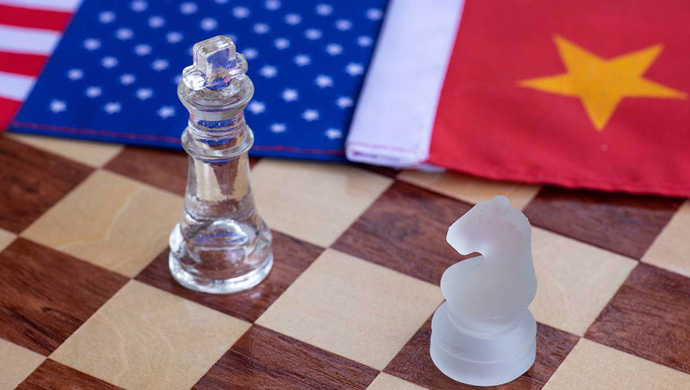
Since the end of 2017, when the leader of the United States openly labeled China a revisionist country and major strategic rival, the U.S. has undertaken a series of hostile and suppressive measures against China in various fields. As a result, political, economic, scientific, technological, military, security and cultural frictions have increased, leading to a serious deterioration of bilateral relations.
The trade and technology war is most eye-catching. However, military and security frictions remain the most dangerous and most likely precursor to conflict and war, especially in the South China Sea and issues related to Taiwan. Moreover, the list of risks with the potential to cause serious military and security frictions is quite long:
• Collapse of the nuclear dialogue between the U.S. and the Democratic People’s Republic of Korea and the subsequent rising tensions on the Korean Peninsula;
• Increased U.S. missile defense assets in East Asia;
• Deployment of land-based intermediate-range missiles and low-yield tactical nuclear weapons in the Asia Pacific (also note that these items will likely force China to expand its nuclear arsenal);
• Accidents in space or cyberspace;
• Increasing uncertainty and negative impacts related to the development of non-nuclear strategic weapons, artificial intelligence weapons and hypersonic weapons and their effect on strategic stability.
With seriously degraded relations, any military security frictions arising from any of these issues may well result in a crisis. And it will be more difficult for the two countries to carry out effective crisis management, as both face increased domestic political pressure and zero-sum thinking. As such, a crisis, once it occurs, can escalate quickly, exposing China and the U.S. to the real danger of more and bigger military conflicts.
In this new situation, if the two countries and their militaries do not want to see bilateral relations slide into the abyss of conflict and confrontation, they must take strong measures as soon as possible to strengthen crisis management in military security. This needs to happen even as they continue to pursue trade negotiations and stabilization their economic, trade and technological ties. It’s in their common interest.
The heads of defense agencies in both countries have already agreed to maintain military-to-military exchanges, to strengthen the management of differences and crises and to turn military relations into a stabilizing element in China-U.S. relations. This understanding is critical and must be put into practice.
With regard to just how China and the U.S. should strengthen their military crisis management, I have some specific suggestions:
First, the focus of crisis management should be the South China Sea, Taiwan, cybersecurity and the Korean Peninsula. The South China Sea is different from the Taiwan question. For the former, both sides should make clear their respective bottom lines as soon as possible. For the latter, the Chinese red line is very clear. If the U.S. chooses to cross it, the risk of crisis and conflict will be huge. With improved China-Philippines and China-Japan relations, the likelihood of a China-U.S. crisis triggered by a third-party factor has decreased, but this risk must not be taken lightly.
Second, to strengthen crisis management, the two sides must insist on having and strengthening military security dialogues that include the topic of crisis management. Conditions should be created for some stalled dialogues to resume as soon as possible, including the joint staff and diplomatic and security dialogues.
Third, hotlines between the Chinese and U.S. heads of state, as well as defense ministries or departments, must be explicitly given a crisis-management function, which should be strengthened to help ensure the prevention and, if needed, the control of destabilizing events. The two sides should also consider establishing hotlines between their relevant theaters of operation.
Fourth, senior government and military leaders should reach common understandings on the basic principles of crisis management. During a dialogue about security crisis management between the China Foundation for International and Strategic Studies and the Carnegie Endowment for International Peace, the two sides jointly proposed some basic principles: keeping communication channels open and sending clear signals, responding symmetrically and acting on the basis of interests rather than ideology. If these could become part of a high-level mutual understanding, they would be of great significance for better crisis management.
Fifth, the Chinese and U.S. militaries should strengthen maritime military security consultation mechanisms by earnestly implementing and further substantiating two key memorandums of understanding — one about mutual notification of major military operations and the other dealing with a code of conduct on military security for operations in and on the high seas. But is it possible for the two sides to establish a permanent joint working group for the prevention of and response to sea and air emergencies? They should do this. In the new situation, crisis avoidance should be the first priority.
Sixth, China and the United States should strive for the early start of a strategic stability dialogue. The dialogue should focus on strategic nuclear relations and also address the related issues of space and cyberspace security, as well as U.S. missile defense deployments and possible deployment of ground-based intermediate-range missiles in the Asia Pacific region.
Seventh, trilateral security dialogues involving China and the U.S. should be conducted and gradually developed into a dialogue between China and the military allies of the United States, with a view toward putting an end to long-standing antagonism. The main tasks of these dialogues should be to develop confidence-building measures, reduce misperceptions and miscalculations, carry out crisis management and develop non-traditional security cooperation.
Since the end of 1990s, China, the U.S. and Japan have all put forward similar proposals. An agreement was even reached in 2009 to start a dialogue. Those opportunities were all missed. Now it is the time to engage again.
